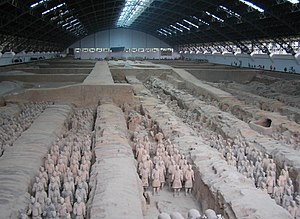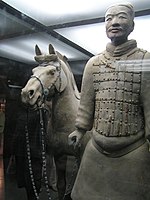Terracotta Army
| UNESCO World Heritage Site | |
|---|---|
 | |
| Criteria | Cultural: i, iii, iv, vi |
| Reference | 441 |
| Inscription | 1987 (11th Session) |
The Terracotta Army (simplified Chinese: 兵马俑; traditional Chinese: 兵馬俑; pinyin: bīngmǎ yǒng; lit. 'soldier and horse funerary statues') or Terracotta Warriors and Horses is a collection of 8,099 larger than life Chinese terra cotta figures of warriors and horses located near the Mausoleum of the First Qin Emperor (Chinese: 秦始皇陵; pinyin: Qín Shǐhuáng líng). The figures vary in height according to their rank; the tallest being the Generals. The heights range is 184-197cm (6ft - 6ft 5in), or more than a full foot taller than the average soldier of the period. The figures were discovered in 1974 near Xi'an, Shaanxi province, China.
Introduction


The Terracotta Army was buried with the Emperor of Qin (Qin Shi Huangdi) in 210-209 BC (his reign over Qin was from 247 BC to 221 BC and unified China from 221 BC to the end of his life in 210 BC). Their purpose was to help rule another empire with Shi Huangdi in the afterlife. Consequently, they are also sometimes referred to as "Qin's Armies".
The Terracotta Army was discovered in March 1974 by local farmers drilling a water well to the east of Mount Lishan. (The precise coordinates are 34°23′5.71″N 109°16′23.19″E / 34.3849194°N 109.2731083°E.) Mount Lishan is also where the material to make the terracotta warriors originated. In addition to the warriors, an entire man-made necropolis for the emperor has been excavated.
Construction of this mausoleum began in 246 BC and is believed to have taken 700,000 workers and craftsmen 38 years to complete. Qin Shi Huangdi was interred inside the tomb complex upon his death in 210 BC. According to the Grand Historian Sima Qian (145 BC-90 BC), the First Emperor was buried alongside great amounts of treasure and objects of craftsmanship, as well as a scale replica of the universe complete with gemmed ceilings representing the cosmos, and flowing mercury representing the great earthly bodies of water. Pearls were also placed on the ceilings in the tomb to represent the stars, planets, etc. Recent scientific work at the site has shown high levels of mercury in the soil of Mount Lishan, tentatively indicating an accurate description of the site’s contents by historian Sima Qian.
The tomb of Qin Shi Huangdi is near an earthen pyramid 76 meters tall and nearly 350 square meters. The tomb presently remains unopened. There are plans to seal off the area around the tomb with a special tent-type structure to prevent corrosion from exposure to outside air. However, there is at present only one company in the world that makes these tents, and their largest model will not cover the site as needed.[citation needed]

Qin Shi Huangdi’s necropolis complex was constructed to serve as an imperial compound or palace. It comprises several offices, halls and other structures and is surrounded by a wall with gateway entrances. The remains of the craftsmen working in the tomb may also be found within its confines, as it is believed they were sealed inside alive to keep them from divulging any secrets about its riches or entrance. It was only fitting, therefore, to have this compound protected by the massive terracotta army interred nearby. In July 2007 it was determined, using remote sensing technology, that the mausoleum contains a 90-foot tall building built above the tomb, with four stepped walls, each having nine steps. Researchers theorized it was built "for the soul of the emperor to depart."[1]
Construction

The terracotta figures were manufactured both in workshops by government laborers and also by local craftsmen. It is believed that they were made in much the same way that terracotta drainage pipes were manufactured at the time. This would make it a factory line style of production, with specific parts manufactured and assembled after being fired as opposed to crafting one solid piece of terracotta and subsequently firing it. After completion, the terracotta figures were placed in the pits outlined above in precise military formation according to rank and duty.
The terracotta figures are life-like and life-sized. They vary in height, uniform and hairstyle in accordance with rank. The colored lacquer finish, molded faces (each is individual), and real weapons and armor used in manufacturing these figures created a realistic appearance. The weapons were stolen shortly after the creation of the army and the coloring has mostly faded. However, their existence served as a testament to the amount of labour and skill involved in their construction. It is also proof of the incredible amount of power the First Emperor possessed to order such a monumental undertaking as the manufacturing of the terracotta army. People believe that the terracotta warriors were based on true people as every face has different facial features and expressions.
Destruction and gradual decay

There is evidence of a large fire that burned the wooden structures once housing the Terracotta Army. The fire was described by Sima Qian, who described them as the consequences of General Xiang Yu, who raided the tomb less than five years after the death of the First Emperor, as that the effects of General Xiang’s army included looting of the tomb and structures holding the Terracotta Army, as well as setting fire to the necropolis and starting a blaze that lasted for allegedly three months, though no other recorded great fire in history ever lasted more than seven days (other great notable fires: Great Fire of Rome, 1871 Great Chicago Fire, London fire, Fire of Moscow (1812)). Because of this, only one statue has survived intact: a statue of a kneeling archer. Despite the fire, however, much of the remains of the Terracotta Army still survive in various stages of preservation, surrounded by remnants of the burnt wooden structures.
In 1999, it was reported that warriors were suffering from "nine different kinds of mold", caused by raised temperatures and humidity in the building which houses the soldiers, and the breath of tourists.[2] In addition, South China Morning Post reported the figures have become oxidised grey from being exposed to air, which may cause arms to fall off, noses and hairstyles to disappear. [3] However, the officials dismissed the claims.[4] In Daily Planet Goes to China, the Terracotta Warriors segment reported the Chinese scientists found soot on the surface of the statue, concluding that the pollution introduced from coal burning plants was responsible for the decaying of the terracotta statues.
Terracotta Army outside China

- The Drents museum [5] in Assen (the Netherlands) will display in the period of Februari 2nd to August 31st 2008 a number of warriors of the Terracotta Army as part of their GoChina[6] Project
- The British Museum hosts an exhibition of original and replica warriors together with contemporaneous artefacts from various Chinese museums from 13 September 2007 to 6 April 2008.
- Six of the warriors were displayed at Selfridges department store in British Columbia in 1981 as part of a marketing event called 'East Meets West'.
- Four terracotta warriors and horses from the Mausoleum were displayed at 1982 World's Fair; this was the first time China had participated in a World Fair since 1904.
- In 2004, an exhibit of the terracotta warriors was featured at 2004 Universal Forum of Cultures in Barcelona. It later inaugurated the Cuarto Depósito Art Center at Madrid[7]. It consisted of ten warriors, four other big figures and other pieces (totalling 170) from the Qin and Han dynasties.
- Silent Warriors, 81 original artifacts including ten soldiers, were on display in Malta at the Archaeological Museum (http://www.heritagemalta.org) in Valletta during 2007. (http://www.heritagemalta.org/documents/Silent%20Warriors.pdf)
- 120 objects as well as 20 warriors are on display at the British Museum in London between September 13, 2007 and April 06, 2008 making it the largest ever exhibition outside China.[3]
- Forbidden Gardens, a privately funded outdoor museum in Katy, Texas has 6,000 1/3 scale replica terra-cotta soldiers displayed in formation as they were buried in the 3rd century BC. Several full-size replicas are included for scale, and replicas of weapons discovered with the army are shown in a separate Weapons Room. The museum's sponsor is a Chinese businessman whose goal is to share his country's history.
- Other replicas may be seen at the Royal Armouries in Leeds.

Further reading
- Debainne-Francfort, Corrine. "The Search for Ancient China," (Harry N. Abrams Inc. Pub. 1999): 91-99.
- Dillon, Michael(ed). "China: A Cultural and Historical Dictionary," (Curzon Press, 1998): 196.
- Ledderose, Lothar. "A Magic Army for the Emperor." from "Ten Thousand Things : Module and Mass Production in Chinese Art" ed. Lothar Ledderose, (Princeton UP, 2000): 51-73.
- Perkins, Dorothy. "Encyclopedia of China: The Essential Reference to China, Its History and Culture," (Roundtable Press, 1999): 517-518.
- Richards, Jack C. Interchange 2, Third Edition, (Cambridge University Press, 2005):80.
- Macmanus, Caitlyn. Oxford University specialty in China's history.
References
- ^ China's Terracotta Tomb Hides Mystery, AOL, 2 July 2007.
- ^ World: Asia-Pacific Pollution threat to terracotta army
- ^ Air pollution harms terracotta warriors
- ^ http://www.danwei.org/media_and_advertising/is_the_terracotta_army_in_dang.php
- ^ [1],
- ^ [2],
- ^ Los Guerreros de Xian llegan a Madrid, El Mundo, 28 September 2004.
External links
- UNESCO description of the Mausoleum of the First Qin Emperor
- Charles Billich created the Terracotta warriors traditional symbol as the official turtle image of the 2008 Beijing Bid. Billich's images are represented on a collection of 16 postage stamps.
- Museum of Terracotta Army Travel Guide and Photo Gallery
- The only museum outside China dedicated to Terracotta warriors - featured in Britain
- Skeptic World - Xian Terracotta Army
- People's Daily article on the Terracotta Army
- Wide angle shot of the Terracotta Army (requires Quicktime)!
- Video from the Terracotta Army pit no. 1 - gives general view of the spot and details on the statues
- Photo gallery of the Terracotta Warriors and Xian

